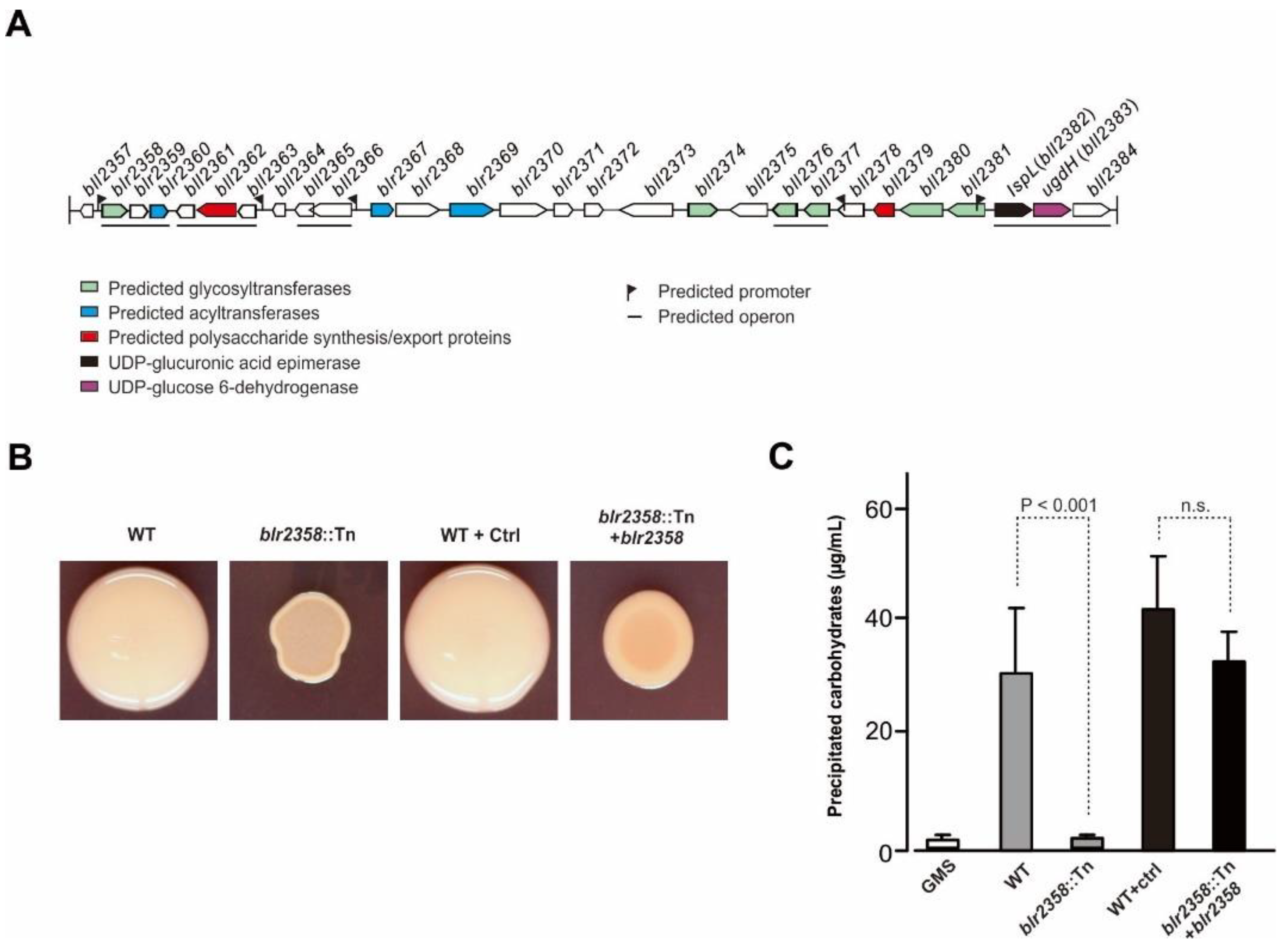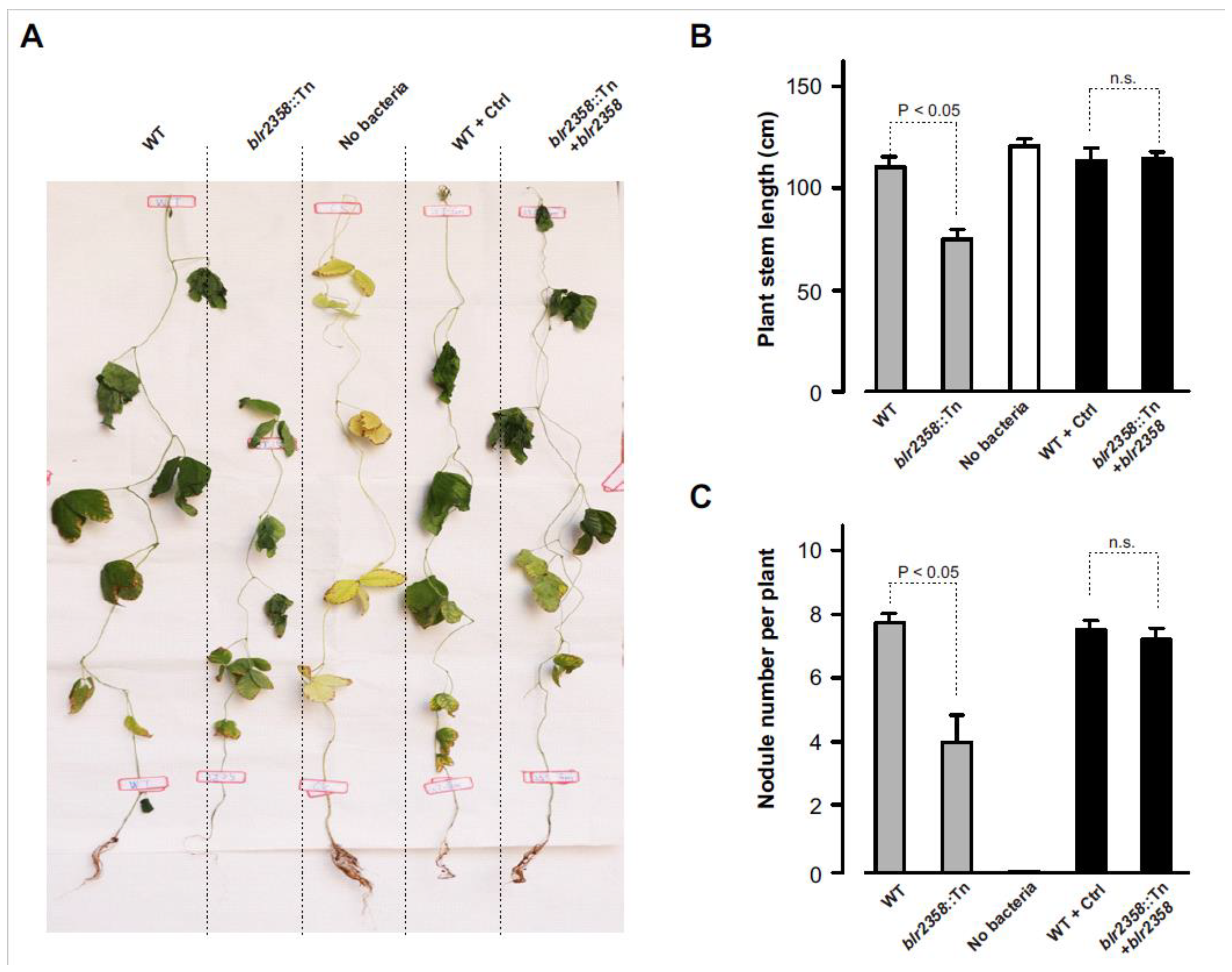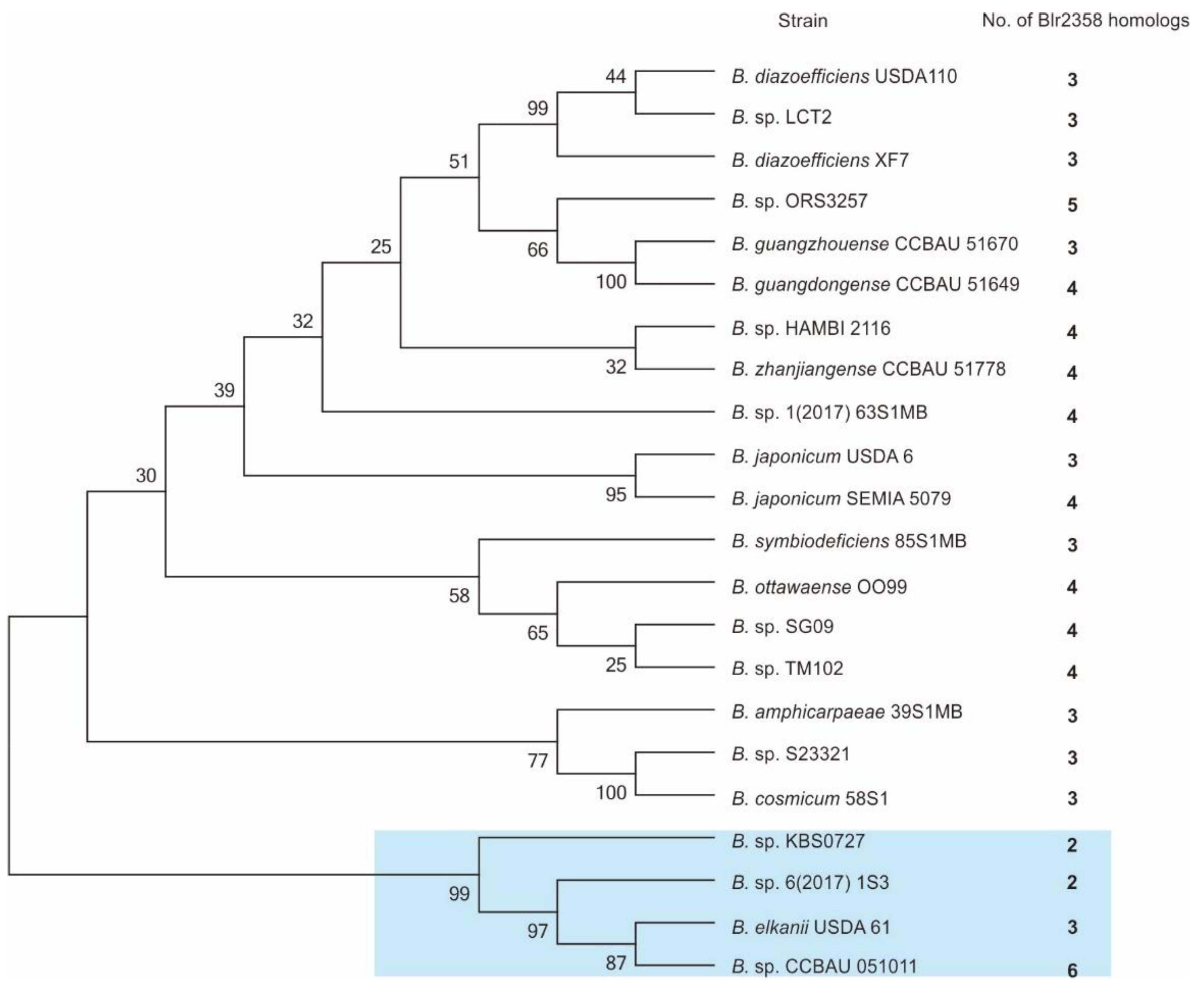Identification of an Exopolysaccharide Biosynthesis Gene in Bradyrhizobium diazoefficiens USDA110
Abstract
:1. Introduction
2. Materials and Methods
2.1. Primers, Plasmids, and Bacterial Strains
2.2. Tn5 Library Screening
2.3. Whole-Genome Short Read Re-Sequencing
2.4. Identification of Tn5 Insertion Sites
2.5. Used Software
2.6. Nodulation Tests with Soybean Plants
2.7. Complementation of the Blr2358 Mutant
2.8. Ethanol Precipitation of Culture Supernatants and Anthrone Tests
2.9. Determination of Carbohydrate Contents
2.10. Preparation of Oligosaccharides from Ethanol Precipitated Polysaccharide
2.11. Mass Spectrometry Analysis of Oligosaccharides
2.12. Analysis of Blr2358 Homologs
2.13. Phylogenetic Tree Analysis
2.14. Statistical Analysis
3. Results
3.1. Phenotypic Screening of a B. diazoefficiens USDA110 Transposon Mutant Library
3.2. Identification of Tn5 Insertion Sites
3.3. Disruption of the Blr2358 Gene Impairs EPS Production
3.4. Soybeans Inoculated with the Blr2358 Mutant Show Reduced Nodule Formation
3.5. Glycosyltransferase Genes Homologous to Blr2358 Are Conserved in the Bradyrhizobium Genus
4. Discussion
Supplementary Materials
Author Contributions
Funding
Data Availability Statement
Acknowledgments
Conflicts of Interest
References
- Wang, L.-X.; Wang, Y.; Pellock, B.; Walker, G.C. Structural characterization of the symbiotically important low-molecular-weight succinoglycan of Sinorhizobium meliloti. J. Bacteriol. 1999, 181, 6788–6796. [Google Scholar] [CrossRef] [PubMed] [Green Version]
- Skorupska, A.; Janczarek, M.; Marczak, M.; Mazur, A.; Król, J. Rhizobial exopolysaccharides: Genetic control and symbiotic functions. Microb. Cell Factories 2006, 5, 7. [Google Scholar] [CrossRef] [PubMed] [Green Version]
- Fraysse, N.; Couderc, F.; Poinsot, V. Surface polysaccharide involvement in establishing the rhizobium–legume symbiosis. Eur. J. Biochem. 2003, 270, 1365–1380. [Google Scholar] [CrossRef] [PubMed]
- Acosta-Jurado, S.; Fuentes-Romero, F.; Ruiz-Sainz, J.-E.; Janczarek, M.; Vinardell, J.-M. Rhizobial Exopolysaccharides: Genetic Regulation of Their Synthesis and Relevance in Symbiosis with Legumes. Int. J. Mol. Sci. 2021, 22, 6233. [Google Scholar] [CrossRef]
- Janczarek, M.; Rachwał, K.; Marzec, A.; Grządziel, J.; Palusińska-Szysz, M. Signal molecules and cell-surface components involved in early stages of the legume–rhizobium interactions. Appl. Soil Ecol. 2015, 85, 94–113. [Google Scholar] [CrossRef]
- Krol, E.; Becker, A. Surface polysaccharides as fitness factors of rhizospheric nitrogen-fixing. In Bacterial Polysaccharides: Current Innovations and Future Trends; Caister Academic Press: Norfolk, UK, 2009; pp. 189–211. [Google Scholar]
- López-Baena, F.; Ruiz-Sainz, J.; Rodríguez-Carvajal, M.; Vinardell, J. Bacterial molecular signals in the Sinorhizobium fredii-soybean symbiosis. Inter. J. Mol. Sci. 2016, 17, 755. [Google Scholar] [CrossRef] [Green Version]
- Parniske, M.; Kosch, K.; Werner, D.; Müller, P. ExoB mutants of Bradyrhizobium japonicum with reduced competitiveness for nodulation of Glycine max. Mol. Plant Microbe Interact 1993, 6, 99. [Google Scholar] [CrossRef] [Green Version]
- Quelas, J.I.; Mongiardini, E.J.; Casabuono, A.; López-García, S.L.; Althabegoiti, M.J.; Covelli, J.M.; Pérez-Giménez, J.; Couto, A.; Lodeiro, A.R. Lack of galactose or galacturonic acid in Bradyrhizobium japonicum USDA 110 exopolysaccharide leads to different symbiotic responses in soybean. Mol. Plant-Microbe Interact. 2010, 23, 1592–1604. [Google Scholar] [CrossRef] [Green Version]
- Becker, B.; Kosch, K.; Parniske, M.; Müller, P. Exopolysaccharide (EPS) synthesis in Bradyrhizobium japonicum: Sequence, operon structure and mutational analysis of an exo gene cluster. Mol. Gen. Genet. MGG 1998, 259, 161–171. [Google Scholar] [CrossRef]
- Rodríguez-Navarro, D.N.; Rodríguez-Carvajal, M.A.; Acosta-Jurado, S.; Soto, M.J.; Margaret, I.; Crespo-Rivas, J.C.; Sanjuan, J.; Temprano, F.; Gil-Serrano, A.; Ruiz-Sainz, J.E.; et al. Structure and biological roles of Sinorhizobium fredii HH103 exopolysaccharide. PLoS ONE 2014, 9, e115391. [Google Scholar]
- Kelly, S.J.; Muszyński, A.; Kawaharada, Y.; Hubber, A.M.; Sullivan, J.T.; Sandal, N.; Carlson, R.W.; Stougaard, J.; Ronson, C.W. Conditional requirement for exopolysaccharide in the Mesorhizobium–Lotus symbiosis. Mol. Plant-Microbe Interact. 2013, 26, 319–329. [Google Scholar] [CrossRef] [Green Version]
- Staehelin, C.; Forsberg, L.S.; D’Haeze, W.; Gao, M.-Y.; Carlson, R.W.; Xie, Z.-P.; Pellock, B.J.; Jones, K.M.; Walker, G.C.; Streit, W.R. Exo-oligosaccharides of Rhizobium sp. strain NGR234 are required for symbiosis with various legumes. J. Bacteriol. 2006, 188, 6168–6178. [Google Scholar] [CrossRef] [Green Version]
- Niehaus, K.; Baier, R.; Kohring, B.; Flaschel, E.; Pühler, A. Symbiotic suppression of the Medicago sativa plant defence system by Rhizobium meliloti oligosaccharides. In Biological Fixation of Nitrogen for Ecology and Sustainable Agriculture; Springer: Berlin/Heidelberg, Germany, 1997; pp. 111–114. [Google Scholar]
- Reuber, T.L.; Walker, G.C. Biosynthesis of succinoglycan, a symbiotically important exopolysaccharide of Rhizobium meliloti. Cell 1993, 74, 269–280. [Google Scholar] [CrossRef]
- Ksenzenko, V.; Ivashina, T.; Dubeikovskaya, Z.; Ivanov, S.; Nanazashvili, M.; Druzhinina, T.; Kalinchuk, N.; Shibaev, V. The pssA gene encodes UDP-glucose: Polyprenyl phosphate-glucosyl phosphotransferase initiating biosynthesis of Rhizobium leguminosarum exopolysaccharide. Russ. J. Bioorganic Chem. 2007, 33, 150–155. [Google Scholar] [CrossRef]
- Laus, M.; Van Brussel, A.; Kijne, J. Role of cellulose fibrils and exopolysaccharides of Rhizobium leguminosarum in attachment to and infection of Vicia sativa root hairs. Mol. Plant-Microbe Interact. 2005, 18, 533–538. [Google Scholar] [CrossRef] [PubMed] [Green Version]
- Mort, A.; Bauer, W. Application of two new methods for cleavage of polysaccharides into specific oligosaccharide fragments. Structure of the capsular and extracellular polysaccharides of Rhizobium japonicum that bind soybean lectin. J. Biol. Chem. 1982, 257, 1870–1875. [Google Scholar] [CrossRef]
- Louch, H.A.; Miller, K.J. Synthesis of a low-molecular-weight form of exopolysaccharide by Bradyrhizobium japonicum USDA 110. Appl. Environ. Microbiol. 2001, 67, 1011–1014. [Google Scholar] [CrossRef] [PubMed] [Green Version]
- An, J.; Carlson, R.W.; Glushka, J.; Streeter, J.G. The structure of a novel polysaccharide produced by Bradyrhizobium species within soybean nodules. Carbohydr. Res. 1995, 269, 303–317. [Google Scholar] [CrossRef]
- Janczarek, M. Environmental signals and regulatory pathways that influence exopolysaccharide production in rhizobia. Int. J. Mol. Sci. 2011, 12, 7898–7933. [Google Scholar] [CrossRef] [Green Version]
- Kaneko, T.; Nakamura, Y.; Sato, S.; Minamisawa, K.; Uchiumi, T.; Sasamoto, S.; Watanabe, A.; Idesawa, K.; Iriguchi, M.; Kawashima, K. Complete genomic sequence of nitrogen-fixing symbiotic bacterium Bradyrhizobium japonicum USDA110. DNA Res. 2002, 9, 189–197. [Google Scholar] [CrossRef]
- Wei, M.; Yokoyama, T.; Minamisawa, K.; Mitsui, H.; Itakura, M.; Kaneko, T.; Tabata, S.; Saeki, K.; Omori, H.; Tajima, S. Soybean seed extracts preferentially express genomic loci of Bradyrhizobium japonicum in the initial interaction with soybean, Glycine max (L.) Merr. DNA Res. 2008, 15, 201–214. [Google Scholar] [CrossRef] [Green Version]
- Regensburger, B.; Hennecke, H. RNA polymerase from Rhizobium japonicum. Arch. Microbiol. 1983, 135, 103–109. [Google Scholar] [CrossRef]
- Sadowsky, M.J.; Tully, R.E.; Cregan, P.B.; Keyser, H.H. Genetic diversity in Bradyrhizobium japonicum serogroup 123 and its relation to genotype-specific nodulation of soybean. Appl. Environ. Microbiol. 1987, 53, 2624–2630. [Google Scholar] [CrossRef] [PubMed] [Green Version]
- Li, H.; Durbin, R. Fast and accurate short read alignment with Burrows–Wheeler transform. Bioinformatics 2009, 25, 1754–1760. [Google Scholar] [CrossRef] [PubMed] [Green Version]
- Martin, M. Cutadapt removes adapter sequences from high-throughput sequencing reads. EMBnet. J. 2011, 17, 10–12. [Google Scholar] [CrossRef]
- Li, H.; Handsaker, B.; Wysoker, A.; Fennell, T.; Ruan, J.; Homer, N.; Marth, G.; Abecasis, G.; Durbin, R. The sequence alignment/map format and SAMtools. Bioinformatics 2009, 25, 2078–2079. [Google Scholar] [CrossRef] [Green Version]
- Camacho, C.; Coulouris, G.; Avagyan, V.; Ma, N.; Papadopoulos, J.; Bealer, K.; Madden, T.L. BLAST+: Architecture and applications. BMC Bioinform. 2009, 10, 421. [Google Scholar] [CrossRef] [Green Version]
- Chikhi, R.; Rizk, G. Space-efficient and exact de Bruijn graph representation based on a Bloom filter. Algorithms Mol. Biol. AMB 2013, 8, 22. [Google Scholar] [CrossRef] [Green Version]
- Chikhi, R.; Medvedev, P. Informed and automated k-mer size selection for genome assembly. Bioinformatics 2014, 30, 31–37. [Google Scholar] [CrossRef]
- Piromyou, P.; Greetatorn, T.; Teamtisong, K.; Okubo, T.; Shinoda, R.; Nuntakij, A.; Tittabutr, P.; Boonkerd, N.; Minamisawa, K.; Teaumroong, N. Preferential association of endophytic bradyrhizobia with different rice cultivars and its implications for rice endophyte evolution. Appl. Environ. Microbiol. 2015, 81, 3049–3061. [Google Scholar] [CrossRef] [Green Version]
- FÅHRAEUS, G. The infection of clover root hairs by nodule bacteria studied by a simple glass slide technique. Microbiology 1957, 16, 374–381. [Google Scholar] [CrossRef] [Green Version]
- Kovach, M.E.; Elzer, P.H.; Hill, D.S.; Robertson, G.T.; Farris, M.A.; Roop, R.M., II; Peterson, K.M. Four new derivatives of the broad-host-range cloning vector pBBR1MCS, carrying different antibiotic-resistance cassettes. Gene 1995, 166, 175–176. [Google Scholar] [CrossRef]
- Loewus, F.A. Improvement in anthrone method for determination of carbohydrates. Anal. Chem. 1952, 24, 219. [Google Scholar] [CrossRef]
- Jessome, L.; Hsu, N.Y.; Wang, Y.S.; Chen, C.H. Matrix-assisted laser desorption/ionization mechanism study with dihydroxybenzoic acid isomers as matrices. Rapid Commun. Mass Spectrom. Int. J. Devoted Rapid Dissem. Up-Minute Res. Mass Spectrom. 2008, 22, 130–134. [Google Scholar] [CrossRef] [PubMed]
- Baraquet, C.; Dai, W.; Mendiola, J.; Pechter, K.; Harwood, C.S. Transposon sequencing analysis of Bradyrhizobium diazoefficiens 110spc4. Sci. Rep. 2021, 11, 13211. [Google Scholar]
- Liu, Y.-G.; Chen, Y. High-efficiency thermal asymmetric interlaced PCR for amplification of unknown flanking sequences. BioTechniques 2007, 43, 649–656. [Google Scholar] [CrossRef] [PubMed]
- Law, I.; Yamamoto, Y.; Mort, A.; Bauer, W. Nodulation of soybean by Rhizobium japonicum mutants with altered capsule synthesis. Planta 1982, 154, 100–109. [Google Scholar] [CrossRef]
- Wong, J.E.; Gysel, K.; Birkefeldt, T.G.; Vinther, M.; Muszyński, A.; Azadi, P.; Laursen, N.S.; Sullivan, J.T.; Ronson, C.W.; Stougaard, J. Structural signatures in EPR3 define a unique class of plant carbohydrate receptors. Nat. Commun. 2020, 11, 3797. [Google Scholar] [CrossRef]
- Kawaharada, Y.; Kelly, S.; Nielsen, M.W.; Hjuler, C.T.; Gysel, K.; Muszyński, A.; Carlson, R.; Thygesen, M.B.; Sandal, N.; Asmussen, M. Receptor-mediated exopolysaccharide perception controls bacterial infection. Nature 2015, 523, 308. [Google Scholar] [CrossRef] [Green Version]
- Kawaharada, Y.; Nielsen, M.W.; Kelly, S.; James, E.K.; Andersen, K.R.; Rasmussen, S.R.; Füchtbauer, W.; Madsen, L.H.; Heckmann, A.B.; Radutoiu, S. Differential regulation of the Epr3 receptor coordinates membrane-restricted rhizobial colonization of root nodule primordia. Nat. Commun. 2017, 8, 14534. [Google Scholar] [CrossRef]
- Chang, W.-S.; Park, K.-M.; Koh, S.-C.; So, J.-S. Characterization of the Bradyrhizobium japonicum galE gene: Its impact on lipopolysaccharide profile and nodulation of soybean. FEMS Microbiol. Lett. 2008, 280, 242–249. [Google Scholar] [CrossRef] [PubMed] [Green Version]



| Mutant Colony | Insertion Position | Targeted Genes | Annotated Functions |
|---|---|---|---|
| BJ#25 | 2561969 | blr2358 | Glycosyltransferase family protein |
| BJ#47 | 449780 | bll0416 (leuC) | 3-isopropylmalate dehydratase large subunit |
| 2561969 | blr2358 | Glycosyltransferase family protein | |
| BJ#57 | 449973 | bll0416 (leuC) | 3-isopropylmalate dehydratase large subunit |
| 2561772 | blr2358 | Glycosyltransferase family protein | |
| Ctrl | - | - | - |
Publisher’s Note: MDPI stays neutral with regard to jurisdictional claims in published maps and institutional affiliations. |
© 2021 by the authors. Licensee MDPI, Basel, Switzerland. This article is an open access article distributed under the terms and conditions of the Creative Commons Attribution (CC BY) license (https://creativecommons.org/licenses/by/4.0/).
Share and Cite
Xu, C.; Ruan, H.; Cai, W.; Staehelin, C.; Dai, W. Identification of an Exopolysaccharide Biosynthesis Gene in Bradyrhizobium diazoefficiens USDA110. Microorganisms 2021, 9, 2490. https://doi.org/10.3390/microorganisms9122490
Xu C, Ruan H, Cai W, Staehelin C, Dai W. Identification of an Exopolysaccharide Biosynthesis Gene in Bradyrhizobium diazoefficiens USDA110. Microorganisms. 2021; 9(12):2490. https://doi.org/10.3390/microorganisms9122490
Chicago/Turabian StyleXu, Chunxia, Huaqin Ruan, Wenjie Cai, Christian Staehelin, and Weijun Dai. 2021. "Identification of an Exopolysaccharide Biosynthesis Gene in Bradyrhizobium diazoefficiens USDA110" Microorganisms 9, no. 12: 2490. https://doi.org/10.3390/microorganisms9122490






